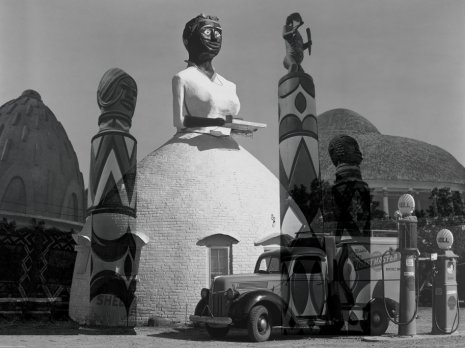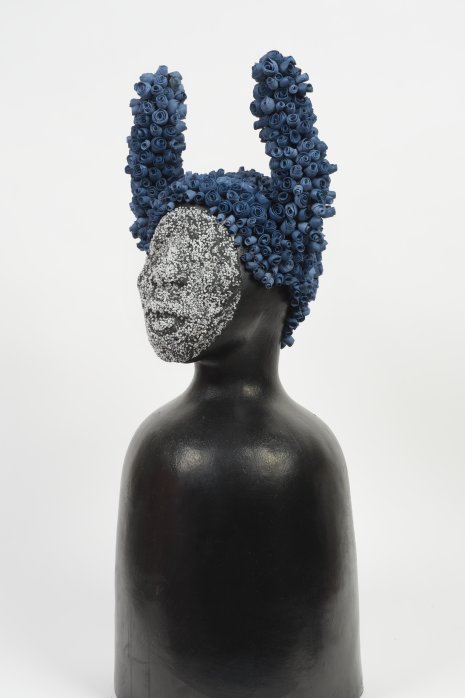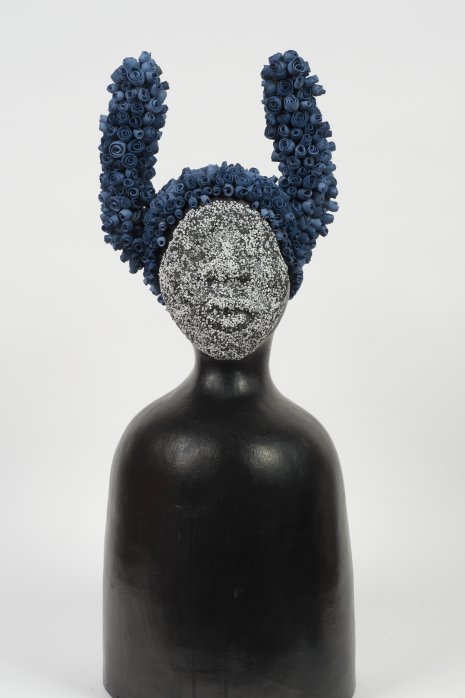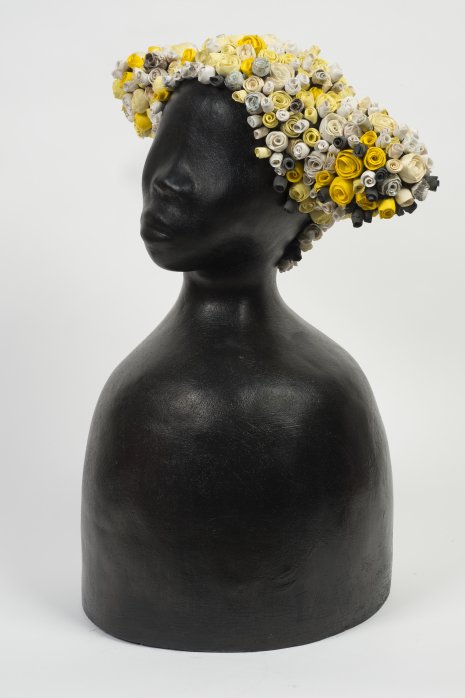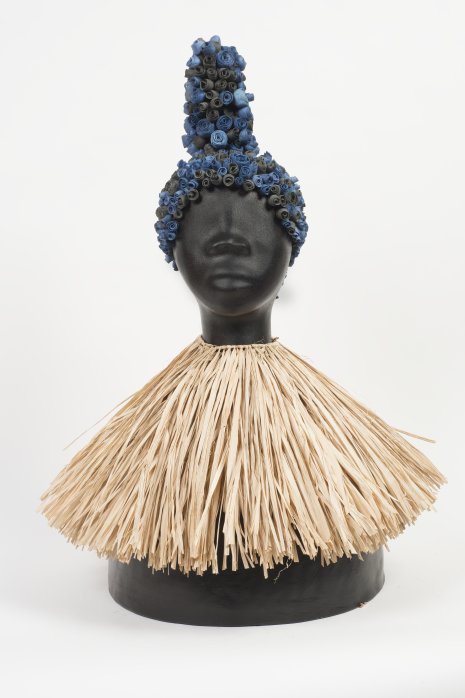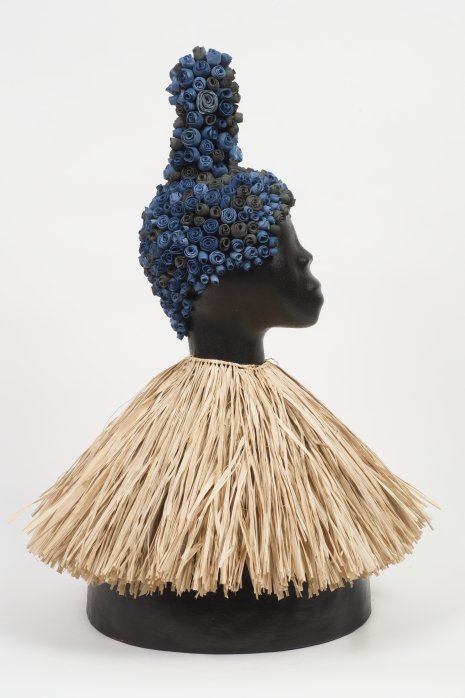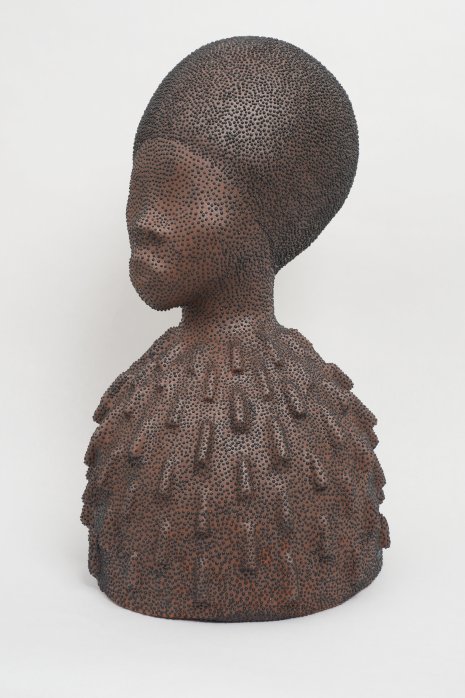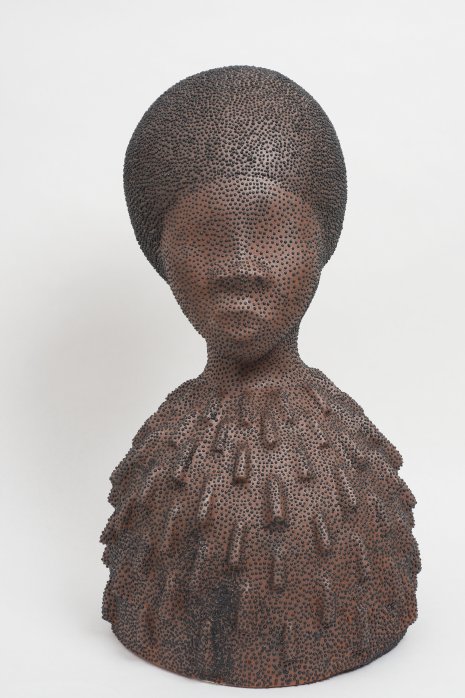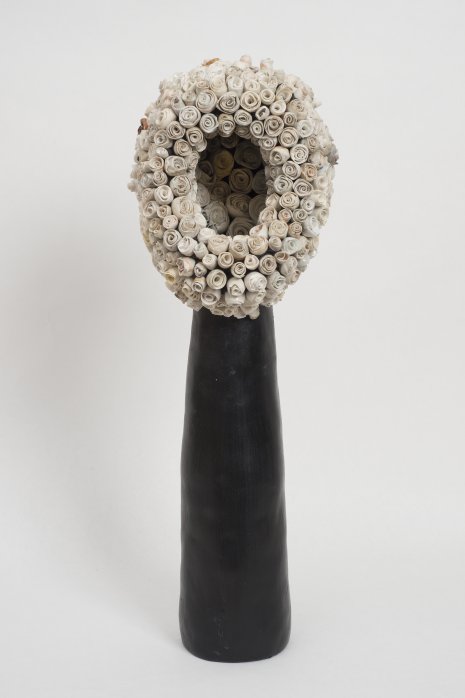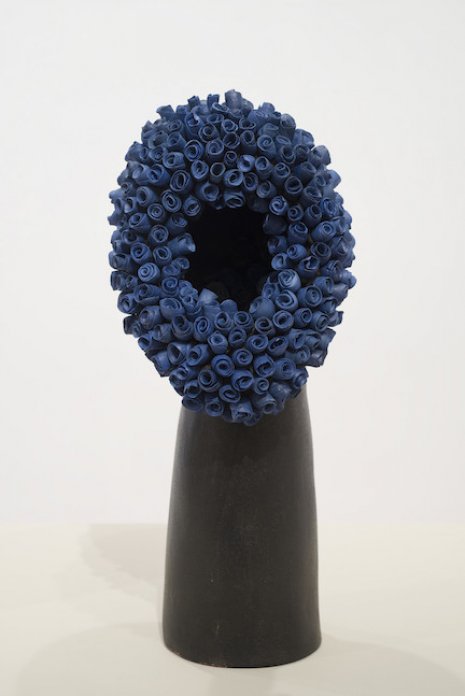This conversation between Simone Leigh and art historian Andrianna Campbell,* took place in Brooklyn, NY in March 23rd 2016.
Simone Leigh enters the room and sits across from me at a long wooden table. Walking into her apartment at midday, I was struck by the buoyant politeness of her teenage daughter and her friend, both of whom were on spring break from Oberlin. They offered me coffee, which brewed while the room became suffused with their light-hearted conversation: a running commentary on their recent clothing purchases. I watched them curiously while sitting down at a section of the table under the skylight, which had cast an elongated rectangle of light between Simone and me. The light served to buffer our interactions as we passed books, computers and art across the table. Simone states that this is the hearth of her home, a place for conversation but also where she assembles her ceramics when she is not fabricating them in the studio. On her laptop in front of us is the mockup for an image she was designing for the Rhode Island School of Design (RISD) Museum Magazine. -- Andrianna Campbell
Andrianna Campbell:
I want to discuss the sources for these photographs used in this image because I think in the design there are so many references to your entire practice. Would you discuss the image itself and your motivations for making it, which you described to me as a joining of three fictional sites?
Simone Leigh:
You are looking at three sites that I have combined: Mammy’s Cupboard, a building in Natchez Mississippi, which is bracketed on the left and right by photographs of two totem-like structures taken from the French Equatorial Africa and the Belgian Congo pavilions, which were recreated for the Exposition Coloniale Internationale de Paris (Paris Colonial Exposition) in 1931. When I was asked to contribute to the magazine, I was told the theme was assemblage, which connects to my mode of working as well as to my interest in combining variegated narratives. This poster for the insert is a combination of some of the source imagery for my sculpture that I have looked at since I was 19. I have not reproduced these except in an archival sense.
AC:
In the case of Mammy’s Cupboard, why do you use the word fiction to describe a site such as this, which still exists?
SL:
Mammy’s Cupboard was a touchstone for inspiring the large hoopskirt of my three Cupboard sculptures. I describe Mammy’s Cupboard as a fiction - even though it is an actual restaurant that’s still functioning - because the image of the mammy is a fiction. First, there is the derivation from Edward Weston’s 1941 photograph of the restaurant, as an example of southern vernacular architecture. Second, I have never visited the site but I am curious about its representation and circulation in our culture as a concrete body that embodies racial fantasies. The building is a large black woman, who wears a dotted handkerchief and carries a tray. A door between her legs invites would-be diners to enter and eat under her skirts, which is a rather perverse abject sexuality that is naturalized in the environment of southern racism. At the same time that you have this blatant sexual objectification of the black female body, the mammy restaurant is clothed in a monumental hoopskirt, which serves as an apparatus for obscuring the body—she has been de-sexed.
AC:
So she is a part of a dialectic in the imaginative narration about how difference is figured in the black female form? Peter Mason suggests the body of the other is never at home, but is constantly marked by its relationship to decontextualization and recontextualization and therefore defined by its displacement. The fiction of the Mammy’s Cupboard, as an accounting of certain desires, makes explicit that process that you can also see in the French colonial project.
SL:
Yes, the degree to which difference is highlighted is very much at the heart of the colonial project. The other two images that are conflated in the RISD poster are two buildings from the exposition in Paris. In 1931, French architects, along with some consultants from the colonies, recreated what they thought were archetypical structures from all the French colonial holdings at that time. It was a re-creation of the colonial project in the middle of Paris while colonialization was still unfolding. Because these structures were recreated and populated from both photographic documentation and projected desires, they are hybrids. In my own work, I'm fascinated with the set of removals necessary for re-enactment.
AC:
The re-enactment as a hybrid is important, because I agree Mason sets up an idea of homelessness that I do not entirely agree with. Homi Bhabha discusses the "unhomed" or the confusion between the home and the world. Here though, I always find Carrie Lambert-Beatty’s idea of the parafiction to be a wonderful touchstone for discussing projects that depart from the real: a practice that has its feet both in the real and in fiction. It intersects the lived world and uses its deception to undermine other claims of facticity that have perhaps been left unquestioned.
SL:
I haven’t read Lambert-Beatty, but it seems relevant. I do often think of Audre Lorde’s Zami, a bio-mythography, which at its heart is a pseudo-biographic novel, a confession. It is nearly a philosophical practice to define how your process will include fiction because it combines memory and my desire. I cull subjective and therefore changing insertions alongside other more seemingly indexical means of documenting narratives. Lourde talks of the power of the voice, the symbols of survival, the powerful woman and she explores those through personal recollections, history and mythology. My process of construction is very similar. When I thought about responding to the image of mammy’s cupboard, I asked myself: what would it mean to examine the archetypes of African-American material culture, and investigate them in the manner I had approached African objects?
AC:
I like this problematic of insider vs. outsider within and outside an already diasporic community and where those borders disintegrate. Were you thinking of looking at this historical legacy of object making from the perspective of the culture-at-large or from the perspective of an African-American? So, I mean were these objects that you were examining always racist or is there a path for certain tropes to migrate between denigration and exultation? I often find when I have been in the South, seeing some of the tropes that you reference like watermelon: some of them are acceptable, subtly racist or overtly racist objects. They either speak to an insider celebration of culture or can make me cringe. You have described the way that the hoopskirt of the mammy could evidence “the strange sexuality of what was typically an asexual archetype” or, to me, could speak of clothing or food choices in monolithically minority communities. On a more physical level, what is your process like handling these loaded archetypes?
SL:
The notion of the skeuomorph, when you replace one object with another one, helps talk about the way I approach sculpture. In a skeuomorph, you leave some aspect of the old object, some residue, so people become comfortable with the replacement. This device mimics the practice of eugenics or some old colonial project; ideas are escorted along stealthily, acting like the skeuomorph. Because the viewer is attached to the old idea and to the older object, this creates a sense of comfort…When I take watermelons and alter them, and then cowry shells and change them, I place them into kilns and transpose them and then I am left with a fragment. I wonder if there’s still that residue there that becomes capable of eliciting fracture instead of the usual complacency and/or comfort.
AC:
The skeuomorph, what a lovely idea. I am so interested in it as a stand-in for a perceptive comfort in the world of computing, but I had not thought about it in relation to your work.
SL:
In this latest group of sculptures at the ADAA Fair I used raffia in two sculptures to give the impression of a collar or a skirt or a thatched roof. In the press for the fair and in the descriptions of my work, I twice saw the word “tribal.” This has never come up before. Raffia is a strong signifier.
AC:
The history of modernism – and James Clifford writes about this – is punctuated by the historic avant-garde looking to African art. How does raffia elicit this kind of response unlike the chair caning in a Picasso?
SL:
As you are describing, representational mark making in many different African societies was often ignored until the late 1980s and ‘90s. Perhaps some of my forms couldn’t be read as influenced by African art and architecture until I used the raffia in their construction. The material carries the weight that is the post-colonial weight.
AC:
How I wonder does your role as a woman of color figure into this conceit?
SL:
As a woman of color, I am always striving to preserve my authorship. A sense of an author, who is individualized that is not simply derived form a grand African diaspora but can be specific to my research and experience. With the avant-gardes, there is the assumption that they “created" modernism. Various strategies that they used came from African objects, which avant-garde artists acknowledged. I am interested in how when I mine similar strategies of where the power of those objects reside. For instance in the case of the watermelon if you see these caricatures of Obama or numerous black people, watermelons are placed close by. At times, the fruit has no relation to the event; however it mere proximity to a black body creates the insult. Objects can become powerful in relation to the body.
AC:
Exactly, and you think about it as an object…a luscious fruit. Why is it...? (Laughs)
SL:
(Laughs) Yes, despite its origin in southern Africa, it does feel almost random, you know?
AC:
To step away from the historical legacy, and see it in the present…the placement of the fruit has this accidental quality in its signification of blackness. It does not facilely communicate an insult in the way that, say, portraying someone as an ape or “primitive” would. What does that say about the way meaning adheres to objects?
SL:
I keep returning to sculpture. I am involved in social practice and performance but I consider myself a sculptor—so much work can be done by an object. Earlier you asked about Mammy’s Cupboard; for us it speaks loudly, but there are a lot of other ways in which it keeps on perpetuating a set of ideas that are not explicitly expressed. We automatically know, “a mammy is bad,” but we’re not really deconstructing how all of these surfaces, objects, and relationships work. As a sculptor, I find that process of extraction and abstraction to be physical and not merely philosophical.
AC:
Does your project relate to how images circulate and sometimes lose meaning? When I was sitting in a grad school class right after Obama got elected—and before all these incidences of racial violence became public news—we were talking about Aunt Jemima, Mrs. Butterworth and mammy images. A Harvard-educated woman in the class said “this doesn’t matter because we don’t live in this universe anymore. We live in a post- racial society.”
SL:
Exactly. (Laughs)
AC:
I said, “Really?” But then I thought her statement was telling, because she is a lovely person, and earnestly couldn’t see the legacy of the mammy figure. It just didn’t compute for her; and therefore its invisibility in certain moments and rapid visibility in others became a primary focus of my research. Would you talk about why this source material is a departure point even if you can’t always discern it in your work?
SL:
I make sculpture where I’m acknowledging that I’m not representing the authentic or real. When you are making objects that intersect with black culture and bodies, the approximation of the real becomes a question asked often of you. In the beginning of my practice, I spent days laboring over what others considered an authentic experience and where I stood. I decided to navigate this world of fiction in order to escape a Sisyphean task of creating an authentic representation; instead I focus on a certain fraudulence embedded in the creative act.
AC:
I am teaching a graduate seminar at Yale about this. An artist, who has hyper-visible identifications, makes work that addresses the body, and critics collapse the author into the object with more frequency than with other normatively positioned authors. It’s important for viewers to realize that there’s a distance between your work and you the creator.
SL:
I am not making self-portraiture in any way, shape or form, even though there is an impulse in the reception to read the work in that way.
AC:
You like to play with these different modes of authorship. When did it occur to you that you could speak through someone else and they could do so with you in order to arrive at often disconcerting results?
SL:
Again, it began with my training at a time when issues of identity were raging in institutions…Remember the movie Ghost?
AC:
This is not where I thought this conversation was going.
SL:
Very funny…well I was in college at the time it came out. Elizabeth Alexander’s book on Saartjie Baartman, the Hottentot Venus, was a hot button topic because it both discussed her exhibition as an exotic object of desire and also the display of her genitalia at Musée de l'Homme in Paris after she died. It opened me up to thinking about the desexualized black female body.
AC:
But really hyper-sexualized as well, I mean, because you see the drawings of her, and she’s very curvaceously depicted.
SL:
Completely over the top, and she functions as a foil for white Parisian women. Fashionable Parisians are wearing bustles at the time. Parisian fascination with and abhorrence mocks this woman. When Ghost came out, it was not the type of film that I would normally watch, but because Whoopi Goldberg was in it and it was so popular, I went to see it. I was taken with the scene at the end where Whoopi serves as a medium of the male character.
AC:
The Patrick Swayze character.
SL:
Patrick Swayze and Demi Moore are able to embrace in a graphic sexual interaction at the end with Whoopi as the medium. The scene had to use a black woman. Whoopi could not be a sexual threat who could date or marry either of the characters.


